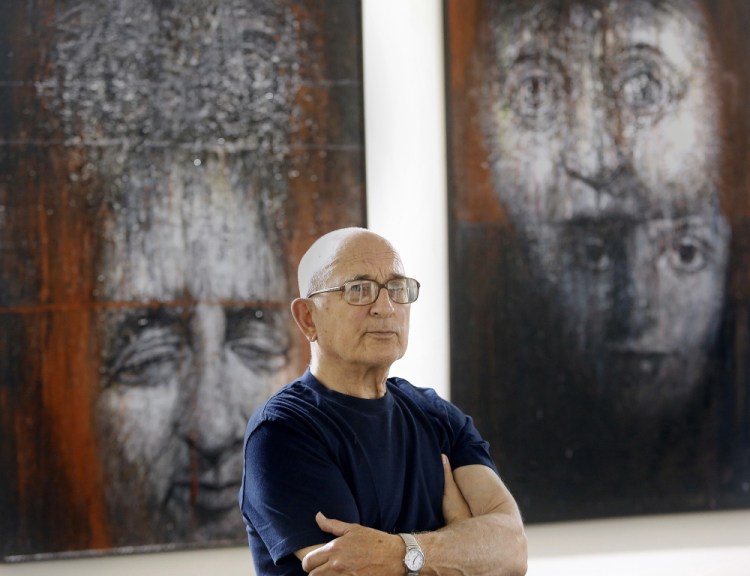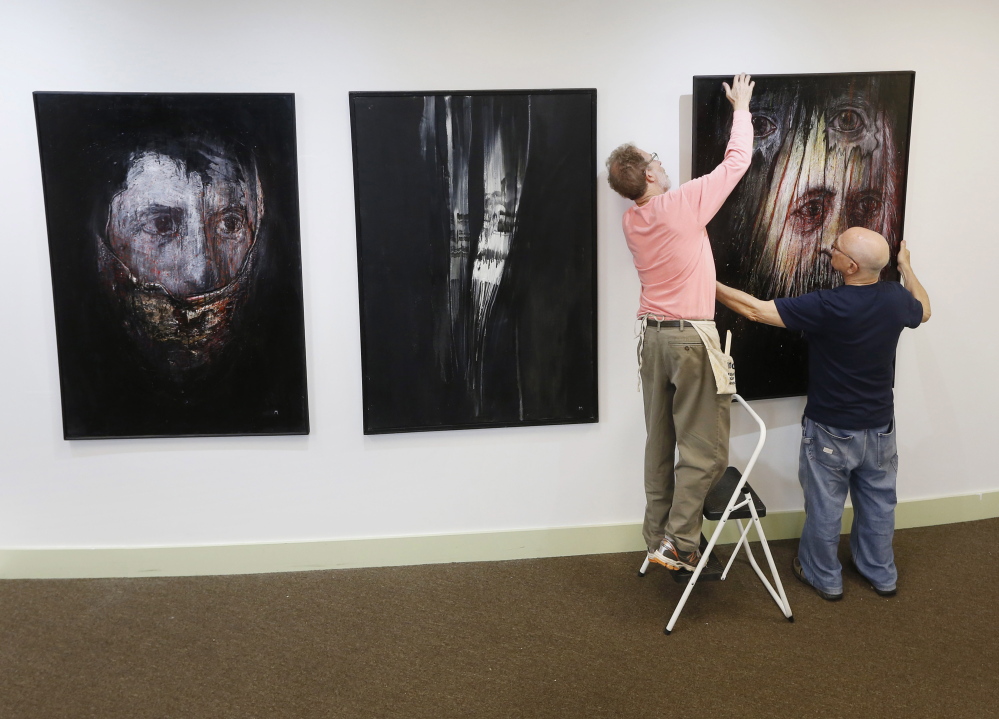WISCASSET — Leonard Meiselman settled in his New York studio one day in 2000 with a brush in his right hand, his oil paints before him and a canvas in front of him. He wanted to paint what he had painted for years: Something abstract. Instead, he painted a prayer shawl from Auschwitz.
For the next three years, he painted prayer shawls. When he moved to Maine two years ago, he thought he had long put the shawls behind him.
“I came to Maine to paint the trees,” he said.
But, when he settled in the basement studio of his house on a tidal marsh in Wiscasset, the shawls emerged.
“I couldn’t stop,” he said. “It was obsessive.”
The dark, thickly painted shawls, which sometimes reveal a human face and eyes, are part of a group exhibition at the Holocaust and Human Rights Center of Maine.
“The Dilemma of Memory,” on view through November, also includes the work of other Maine visual artists and poets responding to the Holocaust. The title of show refers to our conflict, as humans, in remembering a horror so great as the Holocaust, a genocide that resulted in the death at the hands of the Nazis of 6 million Jews during World War II.
We don’t want to remember, but how can we forget, asked David Greenham, program director at the Holocaust and Human Rights Center in Augusta and worked with Meiselman to coordinate the show.
“The Holocaust has cast a pall about what it means to be a human being,” Greenham said. “This exhibition is about Maine artists and their reaction to the Holocaust. It’s a beautiful show, but not depressing. It’s compelling and actually quite inspiring.”
With words and images, “The Dilemma of Memory” attempts to articulate both the sorrow of the Holocaust as well as the strength of the human spirit that helped people – Jews and others – to rise above and continue on, said Meiselman.
Whenever he allows his mind to venture into the topic of the Holocaust, Meiselman said he is consumed by pain and confusion.
“I’m here to share my doubt and confusion,” he said. “I’m not really sure of how to live and how to hold myself in the world with the burden of memories of suffering – the Holocaust, Hiroshima, Vietnam, Darfur. The list goes on. What is the appropriate response? What is the work that I might try to accomplish? How do we who are so fortunate respond?”
His shawl paintings, which have formed the bulk of his artistic output since he first ventured down this creative road, reflect his struggle for his own dignity and sense of wholeness, and his personal understanding.
He cited German philosopher Theodor Adorno, who wrote, “To write poetry after Auschwitz is barbaric.” That quote is often repeated – incorrectly and out of context – as, “After the Holocaust, there can be no art.”
A popular interpretation suggests that the world is so dark and bleak, art cannot possibly shine any light.
Meiselman, who describes himself as a secular Jew, has questioned the ability of art to shine a light in dark places where people have died at the hands of oppressors in numbers too large for the mind to comprehend.
He concludes there is always room for art. Art is an avenue to understanding and to community, where ideas can be exchanged and conversations engaged.
This exhibition attempts to have a conversation about the Holocaust 70 years after it occurred.
In addition to Meiselman, “The Dilemma of Memory” includes photographs by Judy Glickman, sculpture by Robert Katz, paintings by George Mason and Bob Moskowitz, as well as prints by the late Dorothy Schwartz.
The poets are Lee Sharkey, Martin Steingesser, Tony Brinkley, Mark Melnicove and Anna Bat-Chai Wrobel.
The Holocaust has informed Sharkey’s poetry for many years. Relatives of hers were killed in the Holocaust, and she has traveled to her family home in Ukraine for a better understanding of her roots.
The questions posed by the Holocaust are not answerable, she said. “But asking those questions becomes a way of moving to a life that is cognizant of one’s place in a larger troubled world,” she said.
“How do you carry that knowledge, that loss, without being broken by it? How do you understand what happens when the people who can bear direct witness to it are all but gone in the world? How do you carry that weight without wallowing in it?”
She is grateful to Meiselman, who began the conversation that started this exhibition, and to the Holocaust and Human Rights Center for hosting the exhibition. It’s important for people in Maine to understand that serious art that asks hard questions about dark subjects happens here, she said.
“This kind of poetry and this kind of painting is not the face of art that is often reflected when people talk about art in Maine. But it’s here,” Sharkey said. “It’s everywhere.”
She contributed the poem, “In the capital of a small republic.”
It begins, “Tonight I am walking backwards/If I were blind I would know better than to do this.”
Essentially, the poem warns people who dare to explore the Holocaust: You’re going to get hurt if you probe the subject.
Meiselman was so moved by Sharkey’s words that he named one of his painting in the exhibition “Walking Backwards.”
Glickman contributed photographs that she made at Auschwitz beginning in the late 1980s. “The buildings, rooms, objects, the stones, the mass graves, the ashes, the earth itself – all bore witness to the darkest period in recent human history,” she wrote in her artist statement.
Katz began the first of his many journeys to Poland in 1989 to discover the fate of his ancestors at the hands of the Nazis and to understand their lives. He found his roots in the village of Cieszanów. Since then, his art has reflected that personal journey, as he explores Jewish identity, tenacity, survival and loss.
The Holocaust and Human Rights Center was founded in 1985 and based in the Maine State Library for many years. It opened on the campus of the University of Maine at Augusta in 2008, in a new building. Greenham, the former producing artistic director at the Theater at Monmouth, produced “The Diary of Anne Frank” there, and began directing the center after he left the theater.
He has several exhibitions planned that explore Maine’s relationship with bigger-picture stories, including one about the 25th anniversary of the Americans with Disabilities Act and another about the 100th anniversary of the Armenian genocide and Armenian culture in Maine.
Next summer, he will work with the Maine State Museum on an exhibition about Malaga Island off the coast of Phippsburg, which hosted an interracial community from the Civil War until 1911, when the state evicted residents and removed graves.
For Meiselman, 77, “The Dilemma of Memory” represents the first time he has shown his prayer shawl paintings and the largest exhibition of his work since moving to live full time in Maine two years ago.
He came to Maine first as a student at the Skowhegan School of Painting and Sculpture in 1956. He earned a Skowhegan scholarship after graduating from The Cooper Union in New York.
Before enrolling at Skowhegan, he spent a week on Monhegan Island. “I was a kid on the New York streets, and my dream was to live on the coast of Maine,” he said. “Until I came to Maine, I had only seen trees in books and in Central Park.”
A formative art experience occurred when his mother took him at age 10 to the Museum of Modern Art and showed him “Christina’s World,” a famous painting by Andrew Wyeth. It shows a young woman crawling through the grass toward her family home on the coast of Maine.
Meiselman’s mother was born in Russia, and came to the United State at age 3.
“She would stand before her favorite painting and say, ‘See this girl in the grass looking up that house? I know just how that girl feels.’ And she would light up.”
Meiselman paints every day. His paint-splattered studio is a large walk-out basement that leads to a tidal marsh. Living here in the wilds of Maine, with the opportunity to kayak into the fall and watch the ice form and break with the tide, is something he only imagined growing up in New York.
It was this peace he thought he might paint when he came here.
But his mind goes back to Auschwitz and the prayer shawls. His obligation to the memory of death is always just a brush stroke away.
Correction: This story was updated at 8:55 a.m. on Oct. 5, 2014 to correct David Greenham’s title.
Send questions/comments to the editors.





Success. Please wait for the page to reload. If the page does not reload within 5 seconds, please refresh the page.
Enter your email and password to access comments.
Hi, to comment on stories you must . This profile is in addition to your subscription and website login.
Already have a commenting profile? .
Invalid username/password.
Please check your email to confirm and complete your registration.
Only subscribers are eligible to post comments. Please subscribe or login first for digital access. Here’s why.
Use the form below to reset your password. When you've submitted your account email, we will send an email with a reset code.